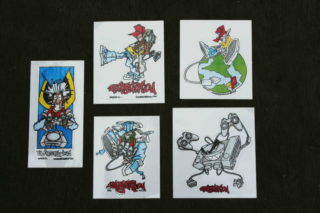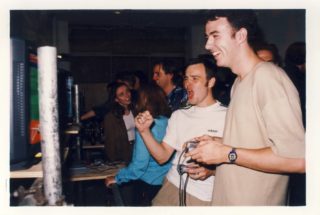PS5 can’t recreate the buzz of the original PlayStation revolution
A new documentary revisits the exhilarating launch of PSOne 25 years ago
Steve Boxer

The world was a very different place 25 years ago.
Whereas now, an air of impending doom is all-pervasive, the early to mid-1990s were heady days. Especially so for gamers, who were about to witness their favourite pastime undergo a cultural shift which would have the by-product of setting the blueprint for the all-conquering games industry as we know it today. Its catalyst was the arrival of the Sony PlayStation.
On 29 September 1995, the PlayStation launched in the UK. To catch a vicarious frisson of the sheer exhilaration of that occasion, the machinations that led up to it and what unfolded subsequently (including changing the games industry as a whole immeasurably for the better), you can now get your hands on a feature-length documentary called The PlayStation Revolution, the third Bedrooms to Billions documentary co-directed by Anthony and Nicola Caulfield.
Full disclosure: I’m in it, so I won’t be offering up a review (even though accusations of bias should be mitigated by the fact that I wasn’t paid a penny for my sound-bites of wisdom). Despite that, I reckon it’s still worth checking out – beyond its mere status as a nostalgia-trip (and anyone except a hedge-fund-owning Brexiter would surely rather be back in the early 90s than the here and now), it makes some illuminating points about gaming’s ascension to the mainstream of pop-culture.
The PlayStation Revolution starts off with some excellent context, examining the console war taking place in the early 90s between Nintendo and Sega (which, gallingly for me at the time as a Nintendo fan-boy, was resoundingly won in the UK by Sega, although the opposite was true in the US). The film’s archive footage makes it clear that both companies assiduously targeted an audience composed of teenage boys.
At the time, writing for the likes of The Sunday Times and The Daily Telegraph, as well as games mags like the nascent Edge and CVG, I saw it as my mission to argue that games weren’t the exclusive province of geeky 13-year-olds. Nobody paid a blind bit of attention to my protestations, of course, but it wasn’t until the PlayStation arrived that I could claim some vindication. On 29 September 1995, the games industry literally grew up overnight.
I knew what was coming – sometime in 1994, I first visited Sony’s Great Marlborough Street office and, by the beginning of 1995, had acquired a Japanese debug PlayStation, with a European debug to follow next year, long before the September 29 launch. The nascent PlayStation office was a buzzy place in which to hang out.

The affable, visionary leader Chris Deering and avuncular Jim Ryan – now President and CEO of Sony Interactive Entertainment – kept the youngsters in check to an extent, amid a revolving cast of interesting characters from various underground scenes who were getting involved, like Christian Stevenson, now known as DJ BBQ, but then a film-making professional snowboarder. You were just as likely to meet graffiti artists, skateboarders or musicians in there.
But for me, the man providing the impetus behind the “PlayStation Revolution” of the documentary’s title was marketing manager Geoff Glendenning. A wild-eyed, fast-talking ball of energy, whose enthusiasm for clubbing and skateboarding knew no bounds, Glendenning cooked up an endless string of guerrilla-marketing activities that left nobody in any doubt that rather than going for a teenage audience, Sony was targeting the PlayStation at 20-something hipsters.
“The nascent PlayStation office was a buzzy place in which to hang out… You were just as likely to meet graffiti artists, skateboarders or musicians in there.”
In those days, every club worth its salt in the entire country would have a crew of people waiting outside when you staggered off home in the small hours, who would thrust a bag of flyers into your hand. Pretty much every one of those would contain a slab of black card flyers, perforated into perfect roach-sizes, emblazoned with the PlayStation logo and a quote from Edge declaring: “It’s more powerful than God”. Never mind that that quote never actually appeared in Edge.
Glendenning explains how he hid the flyers’ purpose, saying: “Chris Deering loved it and he was the one who approved it,” before mimicking Deering’s gentle American drawl: “Yeah, it’s a jigsaw: it’s great; you just put your chewing gum in it.”
Glendenning says: “Even though it was very tongue-in-cheek and risqué, I would say that the perforated card was one of the most successful marketing promotions we ever did.” Remarkably, nobody ever complained about items bearing the Sony logo that blatantly encouraged drug use. However, Glendenning did eventually have to burn his remaining stock of them.

“We paid some people to put that flyer up as a fly-poster at Glastonbury. I thought it was going to be inside Glastonbury, but it wasn’t – it was all around Glastonbury town centre and for miles around. So it was suddenly picked up by the Muslim population, who thought it was blasphemous.” After they threatened Sony corporation with a fatwa, causing extreme consternation at head office in Japan, Glendenning had to weather some considerable flak.

I’ll never forget the launch night for the side-room full of PlayStations that Geoff installed at the Ministry of Sound – legend has it that more than one member of the Ministry’s staff was sacked that night, after being caught neglecting their jobs in favour of playing Ridge Racer or the like. Before long, Glendenning and his team were installing PlayStations at the top clubs all around the UK – no fewer than 52 of them, each containing 10 PlayStations and TVs.
Glendenning also made a branded promotional club-visuals video, which insinuated its way into over 500 clubs, he reckons – and the PlayStation had firmly embedded itself as an integral part of club culture. Which, at the time, was a wondrous and important thing. Covid-19, sickeningly, may just have signed its final death-knell.
“Legend has it that more than one member of Ministry of Sound’s staff were sacked that night, after being caught neglecting their jobs in favour of playing Ridge Racer”
As Glendenning’s influence blossomed – he was promoted to Head of Marketing a few months after launch in January 1996 – he was able to pursue a policy of embedding the PlayStation brand in a number of underground youth cultures. Sony built a skate park under London’s Westway.
Glendenning says: “When you talk about brand positioning, and you pay an agency millions, they’ll say they think you should associate your brand with one particular area of culture. Whereas video games cross over into so many different areas of culture; it gave us a licence to work within board sports, hip-hop culture, graffiti, B-boying, snowboarding, surfing, inline skating, snakeboarding, sky-surfing and the like.
“You’ve got to have the credibility to be there in the first place, but also the work that you do is important. It isn’t so much about stick your logo here, sponsor something and move on; it’s about approaching and supporting areas of youth culture.”
All that effort meant that more or less instantly, the PlayStation was perceived as cool, and gaming suddenly morphed into a socially acceptable pastime – indeed, post-club chillout sessions would often involve reaching for the PlayStation controller.
The development community swiftly and gratefully realised they could make games for people other than teenagers, and responded with the likes of Tomb Raider, Tony Hawk’s Pro Skater, PaRappa The Rapper, Twisted Metal, Metal Gear Solid, Silent Hill and Driver.

But no games epitomised what the PlayStation was all about more precisely than WipEout and WipEout 2097. For its high-octane hover-racing games from 1995 and 1997, Liverpool developer Psygnosis commissioned Sheffield-based design house Designers Republic – already creating a graphic language for most of the top UK dance music labels – to make the game’s accompanying visuals achingly hip. And both games came with licensed soundtracks that made the charts, featuring tracks from Leftfield, The Chemical Brothers, The Prodigy, Orbital, New Order (remixed by Hardfloor), Underworld, Fluke and Future Sound of London.
Remarkably, Glendenning recounts how, after the September 29 launch, Sony still didn’t know whether it had a hit on its hands: “At Christmas 1995, people were still quite nervous about whether it was going to be a success, because Sega had launched six months earlier with the Saturn, although now we know they had really rushed it out, so they didn’t have the software line-up.
“In marketing, with the word of mouth that we had generated, we knew it was going to be huge, but it wasn’t something, in traditional marketing terms, we could quite quantify, other than to say: ‘Just believe us: it’s going to be huge’. And of course, April 1996 was the seminal moment when we dropped to £199, and creamed Sega – outselling them 8.5 to one over Easter.”
For me, the PlayStation did indeed revolutionise the games industry – by turning gaming into a pastime which was not just socially acceptable, but even had an underground, counter-cultural and suddenly cool edge to it. Sadly, although that is touched on in The PlayStation Revolution, the documentary rather buries that most interesting facet of the PlayStation’s story in a morass of technical detail and corporate machinations.
But for those of us who witnessed it, it’s still possible to marvel at the sheer excitement and exhilaration that the PlayStation’s launch engendered. Sure, those were innately exciting and exhilarating times – in stark contrast to the ones we’re currently forced to endure.
But if only Sony can recreate even a tiny percentage of that buzz in November, the PlayStation 5 could end up being the escapism-factory we all turn to.
From Bedrooms to Billions: The PlayStation Revolution is a feature-length documentary featuring interviews with key figures from Sony’s gaming division, past and present.


























